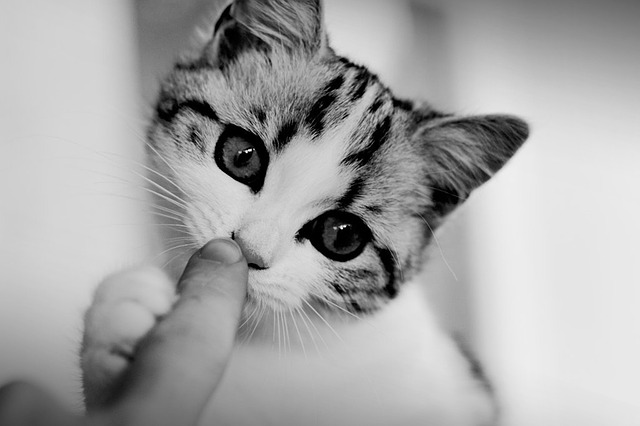Many people think that cats are untrainable; that the idea of walking a cat on a harness or teaching them to sit and give paw is the kind of dream dreamed by lunatics. The truth is that training cats is far more challenging than training dogs, but it’s not impossible. Follow these tips to train your kitten and you could be amazed by her skills.

Trust is the basis of a good relationship
It’s very important to gain the trust and confidence of any kittens you want to train; otherwise kittens may become fearful, reactive and anti-social. Once kittens have negative associations with people, it’s very difficult to change their perception and earn back their trust.
Never, ever use punishment when you train your kitten. Instead, you should always use positive reinforcement by rewarding behavior that is good and that you want your kitten to repeat. Once your kitten has made the connection between a tasty reward and good behavior she will abandon undesirable behavior (which yields no reward) in favor of good (rewarding) behavior.
The problem with punishment
Punishment seems to work because it stops unwanted behavior in its tracks, usually as a result of fear. However, it doesn’t train your kitten what to do instead. It can also teach your kitten that certain behaviors aren’t safe in front of you, so they may start to ‘misbehave’ when you aren’t around and they can’t get caught. For example, using the wrong training and punishing your kitten for urinating on the carpet may teach her that urinating itself is punishable.
As a result, she may stop urinating completely when you’re around or she may urinate in secret places, like behind the couch or under your bed, so you can’t catch her. Compounding the problem is the fact that refusing to urinate for long periods of time can lead to urinary tract problems, which require veterinary treatment.
What to do instead
When your kitten does something you want to discourage, like meowing for food at 4am or scratching on furniture, your best training approaches are to completely ignore her and redirect her to something ‘legal’. Bear in mind that they’re tenacious creatures, so you’ll need a lot of patience and self-restraint, but, in the instance of meowing for food at unreasonable hours, once your kitten learns that this action gets no results, she will abandon the behavior.
In the case of scratching, you need to provide her with fun alternatives, like scratching posts and cat trees, and always gently redirect her to the posts whenever you catch her scratching the sofa. She’ll soon learn where she can scratch to her heart’s content uninterrupted.
Remember: Patience is one of your best tools to reinforce positive behavior and to train your kitten properly. You should also always have a tasty treat close at hand to reward good behavior. Tasty cat treats include dried fish, boiled chicken, tuna and, according to Pets.WebMD.com, meat-flavored baby food. You can also catnip in a toy and use play as a reward when training your kitten. Catnip can be used to keep your cat focused on a scratching post in the beginning training stage, instead of your furniture.
How to train your kitten
The first thing you need to train your kitten is how to focus on you so she can give you voluntary attention.
- Show you that you have a tasty treat. Move it from in front of her nose to between your eyes. As soon as she gives you eye contact say “Yes” or use your clicker and reward her. After five successful lures, take the treat out of your hand and let her follow your finger. Say “Yes” and reward her for eye contact.
The next thing you can train is the sit.
- Hold a treat in front of your kitten’s nose and move it backwards over her head. As her head follows the treat, her bottom should go on the ground. As soon as her bottom hits the ground say “Yes” and give her the reward. Repeat this five times and then take the treat out of your hand and see if she can follow your hand signal only and keep rewarding her for every successful sit.
Cat’s are farsighted and don’t see that well when objects are close, especially if they are still. As result, it may be difficult for them to accept treats from your hand (they simply don’t see them). Pets.WebMD.com, suggests you offer treats on the palm of your hand or toss the treats to the floor, as the movement will allow your cat to see where the treat lands.
Cats are very headstrong, but it’s possible to train your kitten to respond to a recall cue.
- Take a treat and show it to your kitten while you back away a few paces. Say your kitten’s name and “come” in a light and encouraging tone; for example, “Fluffy, come!” When she gets to you, reward her. Keep practicing at a few paces until your kitten responds enthusiastically and without hesitation; then you can start slowly increasing the distance.
You can train your kitten something cute, like paw.
- Hold a treat in your fist and place it in front of your kitten. She may sniff your hand, lick your hand, and perhaps bite your hand to get the treat. Out of frustration she may also paw your hand. As soon as she lifts her paw say “Yes” and reward her. Repeat. Your kitten may run through her entire repertoire of behavior before trying the paw again – as soon as she lifts her paw say “Yes” and reward. She’ll start using her paw sooner and sooner until it is the only behavior she offers. At this point you can take the treat out of your hand and get her to target your empty fist – reward her from the other hand. When she’s doing this consistently you can start putting in a cue, like “Paw” or “Wave” or “Shake”.
Using the basic principles of lure and reward training, with a marker word for the correct behavior (Yes), you can train your kitten to do practically anything.
![Sweet kitten]() The important things to remember are:
The important things to remember are:
- Keep training sessions short. Very young kittens have very short attention spans. To get the most out of the training, do short bursts with breaks in between. For example, 20 – 30 seconds of attention in total (4 or 5 repetitions); 1 minute break; 5 sits; 1 minute break; 5 recalls; 1 minute break; 5 paw – session ends with some belly rubbing or play.You’re looking at a total of about 5 minutes. You can fit in 2 or 3 sessions per day, but don’t push it. If your kitten’s attention flags or she gets frustrated, stop.
- Make sure she is successful. Always break down behaviors into the simplest steps possible so that your kitten can always succeed. Never increase your criteria or expectations too much too soon. Kittens with a history of successful learning and more motivated to continue learning and are more confident that they can learn. Kittens who fail consistently because expectations are too high get frustrated and they dislike training because it’s not fun or rewarding.
- Reward a lot. The more behavior gets a reward, the more often it will be practiced. This is especially important when you start teaching a new behavior. You can fade treats out as your kitten becomes more reliable, but in the beginning your mantra should be: Reward, reward, reward.
It’s best to start training your kitten as soon as possible after you bring her home, but don’t worry if you haven’t started training your adult cat yet. Training cats may be more challenging than training kittens, but it’s still possible.


Comments